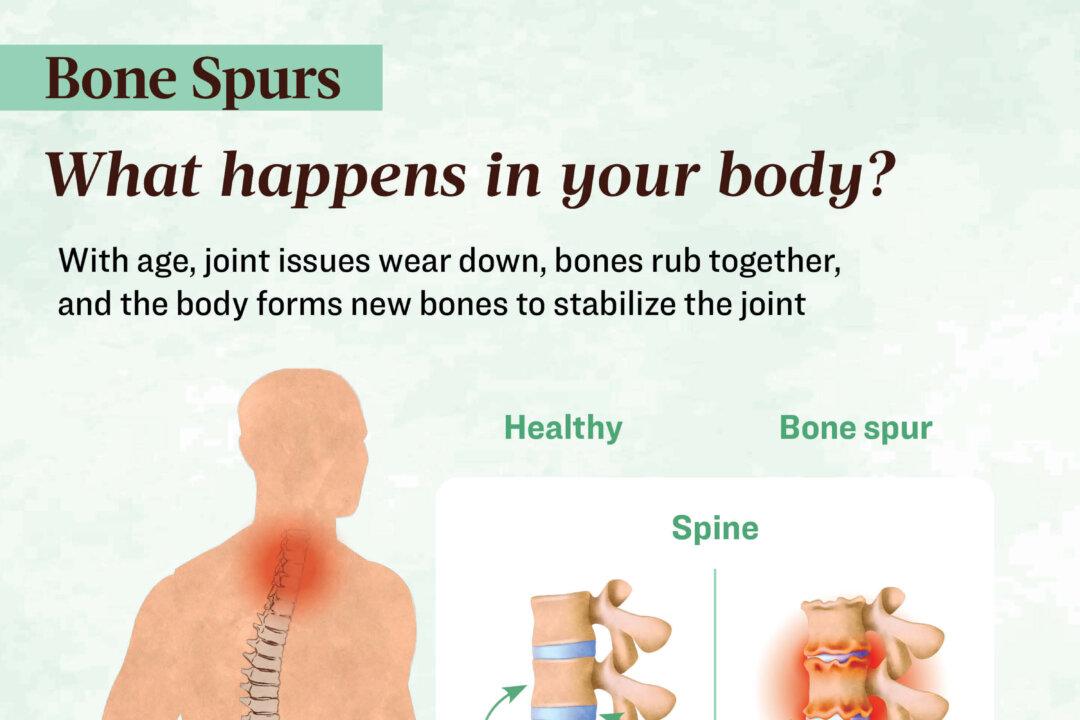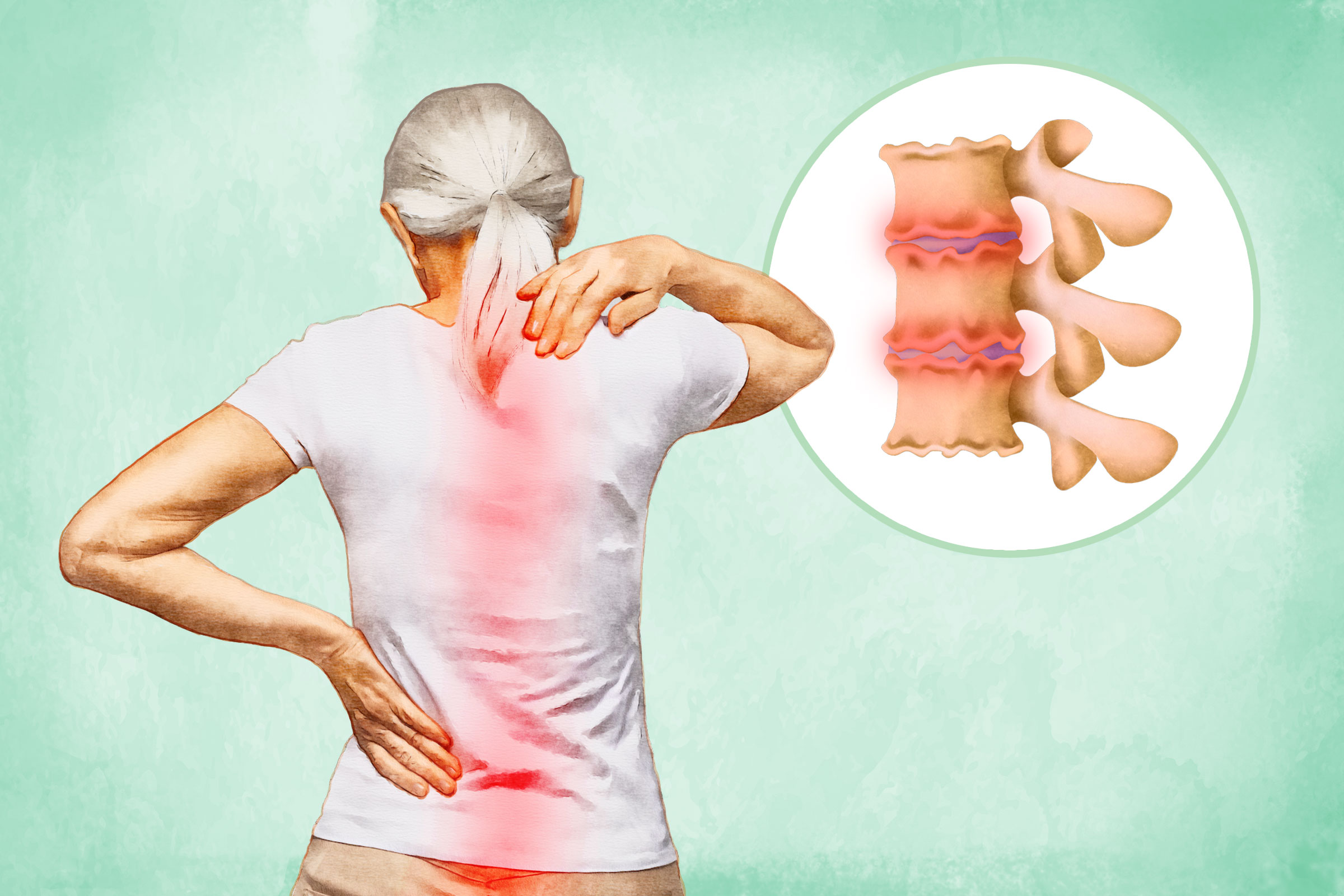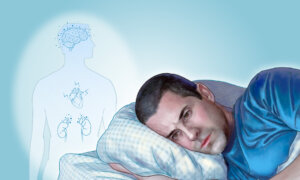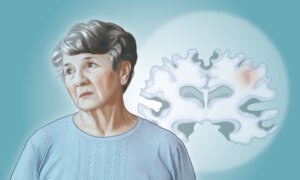
General Symptoms
Bone spurs can go unnoticed for years, but when symptoms do appear, they often result from pressure on nearby nerves, joints, or soft tissue.
- Pain: Bone spurs can inflame the affected joint, causing swelling and tenderness. Surrounding muscles may also become sore. Depending on the location of the bone spur, there may be a dull pain in the neck or lower back when standing or walking. Radiating pain may occur in the buttocks, thighs, shoulders, or head.
- Burning sensation: Bone spurs may trigger a burning or tingling sensation—similar to pins and needles—in the hands or feet.
- Loss of coordination: Bone spurs in the spine, especially in the neck, can compress nerves and interfere with movement, leading to loss of coordination in specific parts of the body.
- Muscle cramps and numbness: Compression or irritation of nearby nerves can lead to muscle cramps or numbness.
- Difficulty controlling bladder: Severe nerve pressure from bone spurs may result in loss of bladder or bowel control.
Location-Specific Signs
The effects of bone spurs vary depending on where they form in the body, with different joints showing distinct signs and symptoms.
- Heel: Heel bone spurs can cause increasing pain and tenderness at the bottom of the heel, which may worsen with activity or after long periods of rest.
- Knee: Knee bone spurs can lead to pain and difficulty straightening or bending the leg.
- Hip: Hip bone spurs can reduce range of motion and cause pain during hip movement.
- Shoulder: Shoulder bone spurs can limit movement and may cause swelling or tears in the rotator cuff—a group of muscles and tendons surrounding the shoulder joint.
- Finger: Finger bone spurs can cause pain during movement, with the joint appearing enlarged or knobby. Lumps may also form on the joints.
Cold and Heat Therapy
Alternating between cold therapy—for pain and inflammation—and heat therapy—for muscle relaxation and increased blood flow, may offer temporary relief.
Physical Therapy
Physical therapy offers significant benefits through targeted exercises—such as calf stretches, plantar fascia stretches, toe curls, and resistance band work—that improve flexibility, build strength, and enhance overall foot function while relieving nerve pressure.
Footwear Modifications
To treat heel spurs, wearing shoes with proper arch support, cushioning, and a secure fit can reduce pressure on the heel and help ease symptoms.
Boswellin
Boswellin is a specialized extract of Boswellia serrata (Indian frankincense). In a 2019 pilot study involving 48 people with knee osteoarthritis, participants were randomly assigned to receive Boswellin or a placebo for 120 days. The results showed that Boswellin significantly reduced pain and stiffness and improved physical function. X-rays confirmed improvements, revealing a wider knee joint gap and fewer bone spurs compared with the placebo group.
Conservative Treatments
In addition to natural and lifestyle strategies, several other nonsurgical treatments may help relieve pain, reduce inflammation, and improve joint function in people with bone spurs.
2. Advanced Treatments
These treatments are usually reserved for people with persistent or severe symptoms.
- Shockwave therapy: Uses sound waves to promote healing and reduce pain
- Corticosteroid injections: Reduce pain and swelling temporarily, but may damage tissue with repeated use
- Platelet-rich plasma: Uses the patient’s own blood platelets to support tissue repair and promote healing
- Radiofrequency treatments: Use noninvasive techniques that may be effective for up to six months, particularly for patients who do not respond to injections
3. Surgery
Surgery for bone spurs is considered a last resort when other treatments fail, as it poses the greatest risk among all options. The surgical approach depends on symptom severity and individual circumstances, such as:
- Percutaneous fasciotomy: A small incision is made to release tight fascia
- Endoscopic fasciotomy: A camera-guided tool is used to release tight fascia
- Fascia debridement: Damaged fascia tissue is surgically removed
4. Acupuncture
Many reviews suggest that acupuncture may be an effective complementary or integrative therapy for managing pain.
- Mindset and pain perception: A resilient mindset may increase pain tolerance and reduce perceived discomfort. Someone with a positive attitude may feel less pain from bone spurs compared to someone who expects the pain to worsen. Focusing on pain can cause the brain to amplify pain signals, making symptoms feel more intense.
- Stress and inflammation: A high stress mindset increases cortisol—a hormone linked to inflammation and joint degradation. Increased inflammation can worsen arthritis, which contributes to bone spur formation. People with a proactive mindset may be more open to practices such as meditation, deep breathing, and mindfulness to help lower cortisol, reduce inflammation, and ease pain.
- Mindset and movement: A fear-based mindset—believing that movement will worsen pain—may lead to inactivity, which can increase muscle stiffness and worsen bone spur symptoms. A positive mindset encourages mobility, and staying active with low-impact exercises—such as walking, swimming, or stretching—can help maintain joint function and prevent stiffness.
- Foramen stenosis: Bone spurs that develop in the foramen—small openings between spinal discs and joints—can narrow these spaces and put pressure on nearby nerves.
- Nerve compression: Bone spurs can press on nerves, causing neuropathy and radiculopathy and leading to pain, numbness, or weakness along the nerve’s path.
- Corns and calluses: Bone spurs in the foot can cause pressure and friction, which may lead to the development of corns and calluses.
- Loose bodies: A bone spur that breaks off can become a loose body that moves within the joint or becomes lodged in the joint lining. These loose bodies can cause the joint to “lock,” making movement difficult. The locking sensation may come and go.
- Rotator cuff disorders: Bone spurs in the shoulder—often from repetitive use—may pinch the rotator cuff tendons and contribute to rotator cuff injuries or degeneration.
Medical History
The patient’s description of their symptoms and medical background is an important part of diagnosing bone spurs.
Physical Examination
The doctor will assess the joint and surrounding tissue, as some bone spurs can be felt while others cannot. The exam includes palpation or touching specific areas, visual inspection, and an evaluation of the gait cycle for signs of swelling, bruising, or heel pain. Range of motion testing may also be performed to assess joint flexibility.
Tests
Imaging tests: A doctor may request additional diagnostic imaging tests, such as X-rays, computed tomography scans, or magnetic resonance imaging, to confirm the diagnosis and assess the affected bones and joints. X-rays are often used to highlight bone changes, especially when symptoms of bone spurs or arthritis are present.
- Wearing proper footwear: Shoes with a wide toe box, arch support, and cushioning can help prevent pressure and friction that contribute to bone spur formation. Supportive insoles may also be helpful, particularly for people with flat feet.
- Using thick socks: Thick socks can reduce rubbing from shoes, which may increase bone friction and contribute to bone spurs.
- Doing weight-bearing exercises: Weight-bearing exercises—such as walking or stair climbing—help keep bones strong and support joint health.
- Maintaining a healthy weight: Staying at a healthy weight reduces joint stress, which may lower the risk of bone spur formation.
- Taking preventative measures: If you notice joint pain, swelling, or stiffness, consult a doctor early to manage arthritis and help prevent bone spurs.








